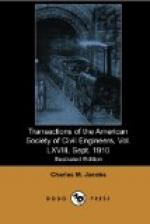During recent years, however, the population of the metropolitan district has increased so enormously that New York is now the greatest terminal passenger and freight traffic center in the country; and in manufactures it ranks first among American cities. The new commercial interests thus created are of at least equal importance with those of the water-borne commerce, although their existence and development are largely the result of the water facilities of the port.
The local passenger and freight traffic of the Pennsylvania and of other railroads reaching the west shore of the North River is conducted by car-floats and ferry-boats which deliver their loads at piers on the Manhattan waterfront and elsewhere in the harbor. These boats obstruct and endanger the free navigation of the channels and occupy space along the waterfront greatly needed for the accommodation of the long-distance water-borne commerce, especially on the North River.
In the East River the importance of ferry-boats as a means of traffic distribution has already been greatly reduced by the construction of bridges and tunnels which provide for the greater part of the passenger and vehicular traffic. The North River, however, by reason of its greater width and the comparative slowness of its currents, is by far the more important waterway for the use of ocean-going vessels of the larger classes. In this river the conditions for the construction of bridges, within the limits of commercial convenience, seem to be practically prohibitory. Tunnels, for the transportation of passengers and the diversion of the freight traffic from the inner waters of the harbor, are apparently the only available means of relief.
When the new line is in operation, a very large part of the New York passenger traffic of the Pennsylvania Railroad will be carried to the New York Station at Seventh Avenue and 33d Street and the rest will go to Cortlandt Street through the Hudson Company’s tunnels. Thus a large portion of the Pennsylvania passenger ferry traffic, which amounts to more than 91,000 passengers daily, will be practically eliminated from the water-transportation problem. In addition, a large part of the Long Island Railroad’s passengers will use the station at Seventh Avenue and 33d Street, and its ferry traffic will be reduced accordingly.
The new arrangements for the transfer of freight from Greenville to Bay Ridge will relieve the inner waters of the harbor of a large volume of obstructive car-float traffic. There appears to be no reason why this traffic should not be eventually conducted through tunnels under the outer harbor, should future transportation conditions justify the enormous cost of such structures.




